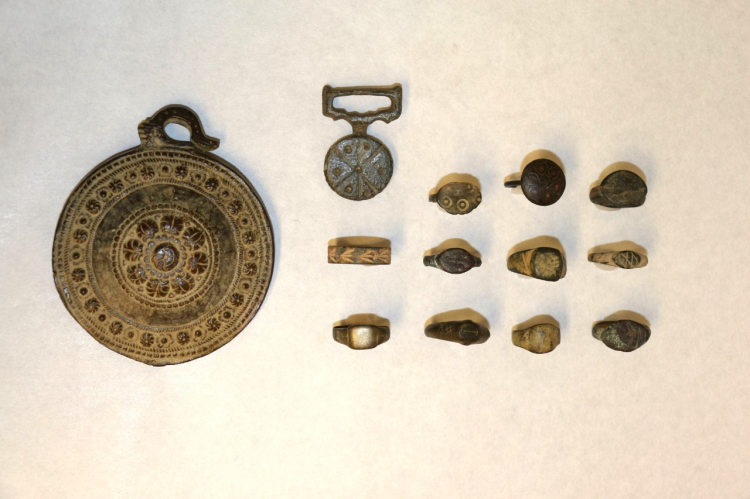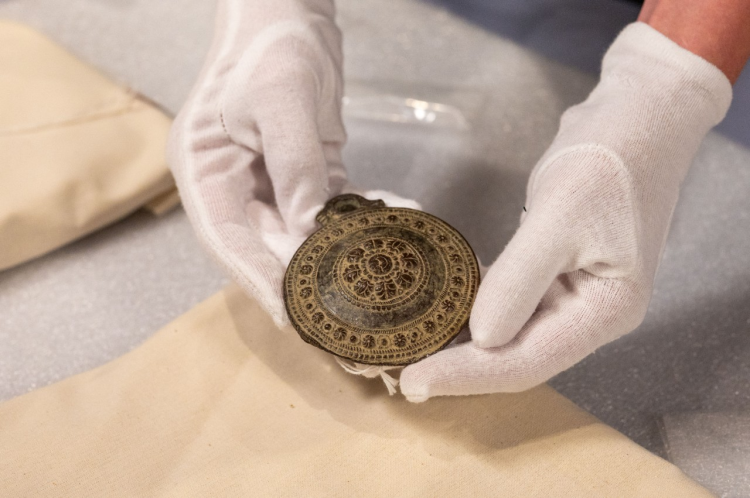Bargain and treasure hunters beware: You never know what you might find at your local thrift shop.
Rare artifacts dating back potentially thousands of years have been found in a British Columbia thrift store and donated to Simon Fraser University for study.
The remarkable discovery of eleven rings and two medallions, thought to date from medieval or Roman times, was made in a Chilliwack thrift shop where they were being sold for $30.
The collection is now in the care of SFU's Museum of Archaeology and Ethnology and will form part of a new archaeology course, where students will get to analyze the designs and materials with a view to identifying where and when the items originate from.
"This is an incredibly exciting donation and an amazing opportunity for students here at SFU," says Sabrina Higgins, associate professor, global humanities and archaeology.
"It will take at least a semester - if not longer - to piece together the origins of these artifacts. We're fortunate to have access to cutting-edge research technologies within our department to properly study these objects, so it promises to be a rewarding journey for students."

The full set of eleven rings and two medallions - SFU/Museum of Archaeology & Ethnology
The artifacts were found at the Thrifty Boutique, which provides vital financial support for the Chilliwack Hospice Society.
A customer with an archaeology background alerted the store's volunteers to the potential archaeological significance of the items. They then approached SFU experts for their assessment.
"It's a privilege for Chilliwack Hospice Society to contribute to the continuing story of these artifacts," says Sue Knott, executive director, Chilliwack Hospice Society.
"Thrifty Boutique offers an upscale thrift shopping experience where you can discover unique new and pre-loved items, many of them treasures metaphorically and, as it turns out, quite literally.
"This story is a beautiful reminder of how every donation carries meaningful history and unknown potential."
Medieval or Roman?
Higgins was the first SFU expert to take a look at the items as she specializes in Rome and late antique archaeology. She believes the artifacts most likely date from the medieval period.
"I think they most likely originate from somewhere within the boundaries of what was once the Western Roman Empire," says Higgins.
"The shapes, designs and construction make me think that these are medieval, as the Romans typically used slightly different materials and techniques."
The artifacts are being cared for at SFU's museum on its Burnaby campus.
Museum director Barbara Hilden says: "The fact that these items continue to exist is quite extraordinary. If they are hundreds or thousands of years old, then at any point along the way they could have been lost, broken or discarded. Yet they've been kept, preserved, and now they're entering a new chapter.
"What we do in museums is tell stories about people and objects. We're really looking forward to telling the stories behind these belongings once we know more about them."

Students will get to study the artifacts as part of a new course - SFU/Sam Smith
SFU's museum does not typically collect items that lack the proper documentation, as there is the risk that such items may have been illegally looted.
Without knowing where these artifacts came from, who owned them or how they acquired them, museum staff and SFU experts had to confront a number of ethical questions before accepting them.
Cara Tremain, assistant professor, Department of Archaeology, says the ethics will be central to the new archaeology course that will begin in fall 2026.
"Opportunities like this are incredibly rare. Students will get the chance to directly confront some of the ethical questions that the museum faced in accepting this collection under these circumstances," says Tremain, who specializes in the ethical and legal aspects of the antiquities market.
"What if they were looted from their original archaeological site? Looting leads to the loss of cultural and scientific knowledge. Should we have advised on bringing them in without knowing where they came from? What would have happened to them if they weren't brought in?
"Students are literally going to have these issues in front of them. Integrating the ethical considerations alongside the hands-on study of this collection is going to be really valuable for students."
Without any archaeological context behind the items, there is also the possibility that they could be forgeries. Even if that were the case, there is still value in studying the items, according to Tremain and Higgins.
"What we're doing is essentially being detectives - we're trying to recover the story of these items," says Tremain.
"They could offer up new information that may change the way we think about that culture or history. In which case, we want to know that we're basing our theories on something that is authentic."
Higgins adds: "Even if these end up being forgeries, there's still an interesting learning experience for the students in terms of going through an object systematically to determine whether it's real, or a forgery, and questioning why forgeries continue to make their way into the antiquities market."
The SFU course will culminate in an exhibition at the museum, which will focus on the history and biography of the artifacts, as well as the ethical considerations that archaeologists and museums face.













